Despite selling two of their most important players this season, Roberto De Zerbi‘s Brighton have made a magnificent start to the Premier League, winning five of their first eight games, placing them sixth, only four points behind the league leaders. Brighton have been well known for exhibiting brilliance in the build-up since De Zerbi arrived last season; they’ve caught the eye for the flexible entertainment and attacking football that, of course, has forced the opposition to work hard to try and stop them.
Our tactical analysis and scout report will provide analysis of a method that’s been used to stifle Brighton’s build-up commonly of late: the diamond shape of pressing that Manchester United, Aston Villa and Liverpool have opted for. Let’s start with a tactical analysis of The Red Devils’ high-pressing tactics against The Seagulls.
Manchester United vs Brighton
Brighton used their 2–4–4 shape during the build-up, with the full-backs, Veltman and Lamptey, pushing forward to be on the same line as the double-pivot Pascal Groß and Mahmoud Dahoud, as well as Danny Welbeck dropping with Lallana to get Casemiro in a 2v1 situation.
On the other hand, Manchester used a 4–4–2 diamond shape while pressing high. Marcus Rashford and Rasmus Højlund pressed the centre-backs, with one of them closing the passing lane towards one of the pivots, leaving the other to be marked by Bruno Fernandes.
Christian Eriksen and Scott McTominay are positioned narrower to close the direct passing lanes towards Welbeck and Adam Lallana on the half-spaces while being ready to press the opposition’s full-backs. Lastly, Lisandro Martínez had to follow Welbeck when he dropped, so Casemiro was focused on Lallana.
Notice below the diamond midfield shape of the home side. Rashford is pressing Jan Paul van Hecke, while Højlund is ready to press Lewis Dunk while keeping Dahoud in his cover shadow, leaving Fernandes to mark Groß. Meanwhile, Eriksen and McTominay are positioned more centrally to close down any possible vertical pass, also marking the full-backs.

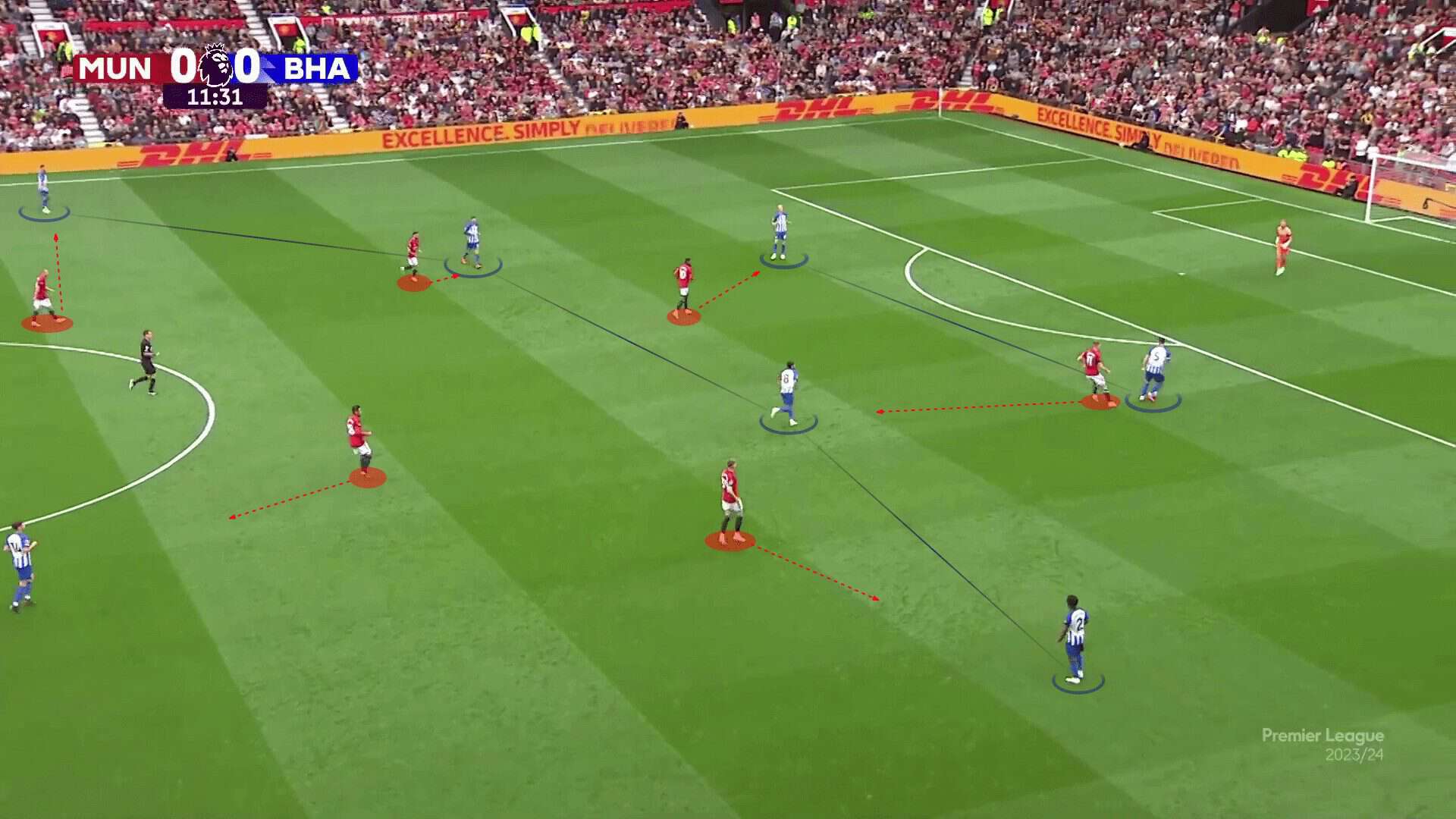
The narrow positioning of Eriksen and McTominay left a marked space for the full-backs on the wide areas. Erik ten Hag’s main intention in pressing was to close any central progression and compromise when the ball reaches the full-backs.
The only solution Brighton had in the first 15 minutes was to escape the press through their full-backs, making use of the long distance between them and their markers. When the full-backs carry the ball, then the wide wingers could move narrower to get the opposition’s full-back in trouble.
As shown below, Jason Steele is playing a direct pass towards Joël Veltman, who receives and carries the ball easily as Eriksen and Casemiro are in a 2v3 situation in midfield against Lallana, Welbeck and Veltman with Simon Adingra’s inside run he pinned Sergio Reguilón, giving the Dutch right-back more time on the ball.


Despite being unable to progress centrally, Brighton still created a threat to Manchester United’s goal, able to escape the press and create scoring chances through their combination play on the flanks. Yes, they prefer to go centrally, but they were also brilliant in the wide areas.
Against the same pressing scheme, Van Hecke can still find a direct pass towards Welbeck, who is able to receive as Adingra’s narrow positioning pinned both Reguilón and Martínez. So now Eriksen is in Between Welbeck and Veltman, the same as Casemiro between both Lallana and Welbeck.Using their brilliant third-man runs, Welbeck passed the ball to Groß, who could receive as Bruno was between him and Dahoud; Groß then found Veltman out wide.
Now, Reguilón has to step out to press Veltman, leaving Martínez in between Adingra and Welbeck; Veltman passes towards Welbeck, who was able to receive and play for Adingra on the right channel, leading to Brighton’s first goal through Welbeck.


However, Brighton still prefer to reach their double-pivot more frequently for better control of the game, as De Zerbi said after the match, so their adaptation was to position both centre-backs Dunk and Van Hecke wider, increasing the distance that should be covered by United’s front three — Fernandes, Rashford and Højlund — so one of the two forwards will not be able to close the passing option for their marker.
As shown below, Dunk is wider than before, increasing the distance required to be covered by Højlund and Rashford. As the distance is longer, Højlund can’t cover shadow Dahoud, who received under pressure from Fernandes. Now, Groß is free to receive from the dropping Lallana. Furthermore, Rashford couldn’t reach Groß as Van Hecke was also positioned wide.


On another occasion in the first half, Steele could directly play the ball to Dahoud, as the opposition’s players couldn’t cover.

Brighton won that game 3-1 thanks to the tactical tweak by De Zerbi during the first half. It was a good tactical idea by Ten Hag despite the loss that gave Unai Emery something to work on, as in game week seven, Aston Villa hosted Brighton, who were in the top five of the league.
Aston Villa vs Brighton
Against the same 2-4-4 build-up shape from Brighton, Aston Villa also used the diamond midfield of Boubacar Kamara, John McGinn, Nicolò Zaniolo and Douglas Luiz behind both Ollie Watkins and Moussa Diaby.
Villa’s pressing scheme depended heavily on both Watkins and Diaby to be centrally positioned along with Luiz to close down on Brighton’s double-pivot — Billy Gilmour and Jack Hinshelwood. Moreover, McGinn and Zaniolo marked Brighton’s full-backs with Kamara against Evan Ferguson and Pau Torres dropping with Welbeck.

When one of the centre-backs had the ball, the ball-side striker pressed him; as shown here, Watkins is pressing Adam Webster in addition to McGinn (the winger opposite to the side of play), who is stepping to press Hinshelwood with Luiz marking Gilmour and Diaby moving towards the goalkeeper to force Webster not to go back to his goalkeeper who can switch the play to the isolated left-back, Pervis Estupiñán as McGinn is no longer marking him. So, now, Webster is forced to go long for his right-back Veltman, and they lose the possession.
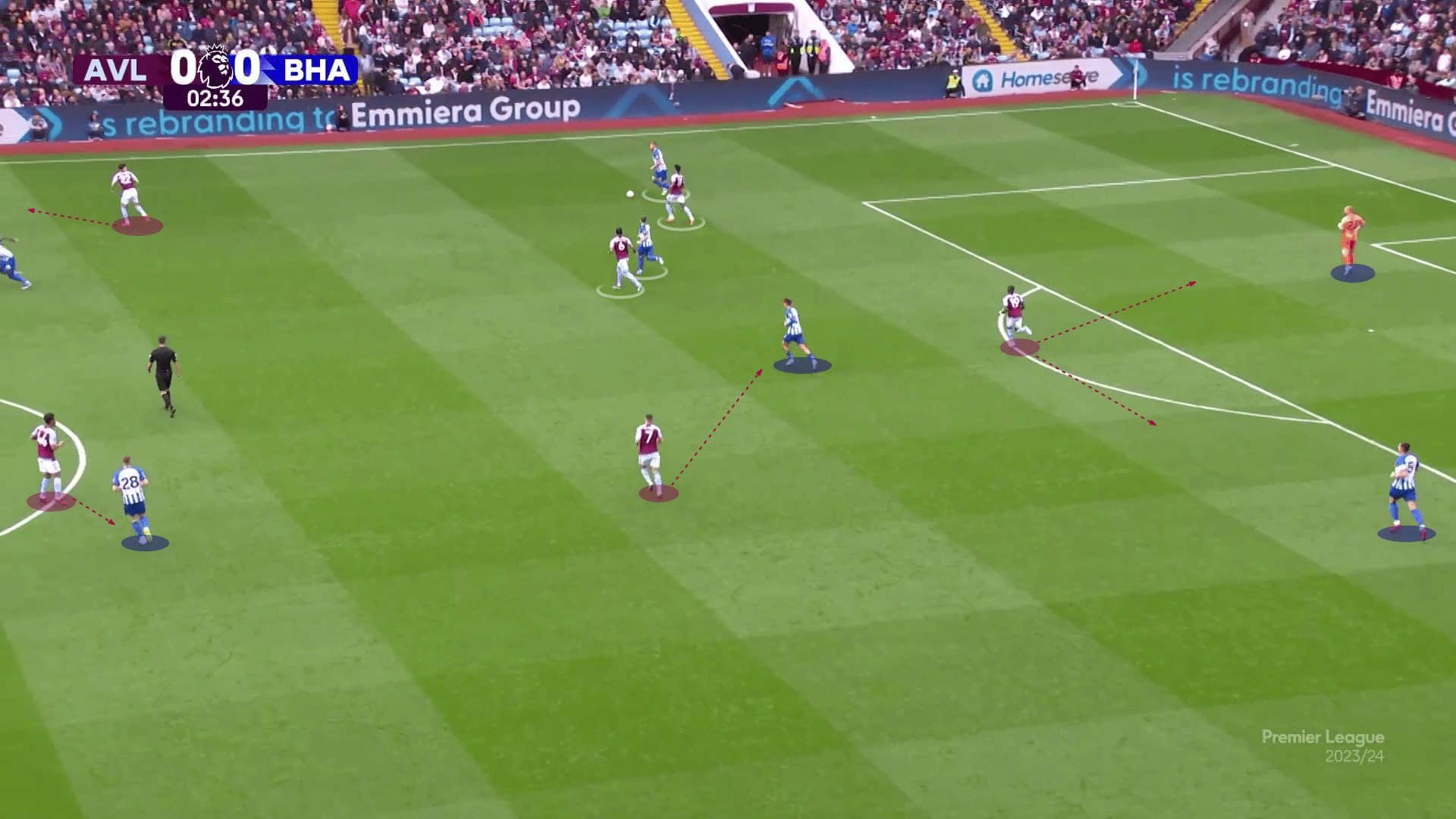
Identically, here we see the same structure from Emery’s side, and Steele is forced to go long towards Estupiñán. McGinn immediately closed down the Ecuadorian, who won a free kick.
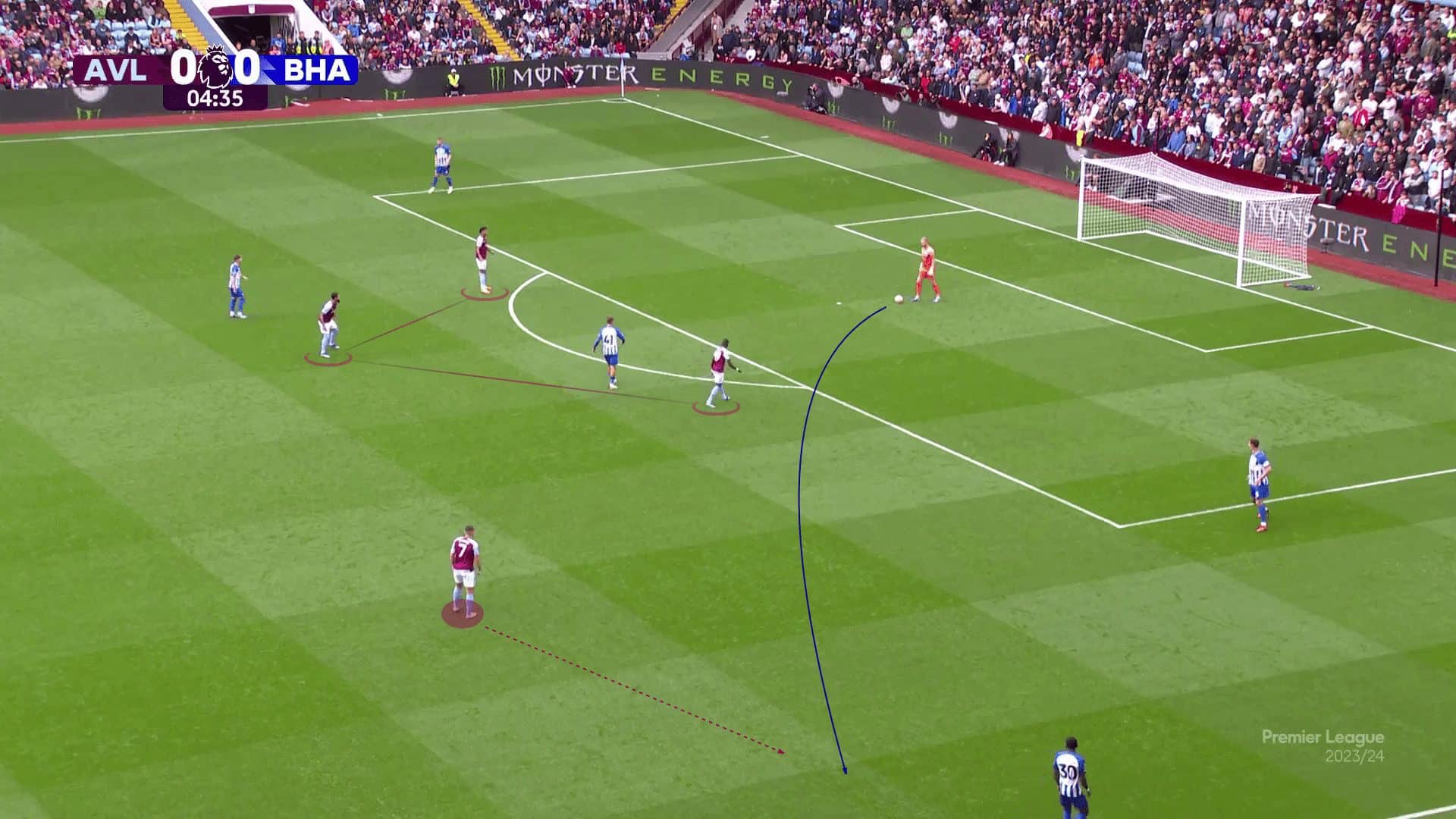

Typically, the same situation — Dunk was forced to go long, and once again, Brighton lost possession.
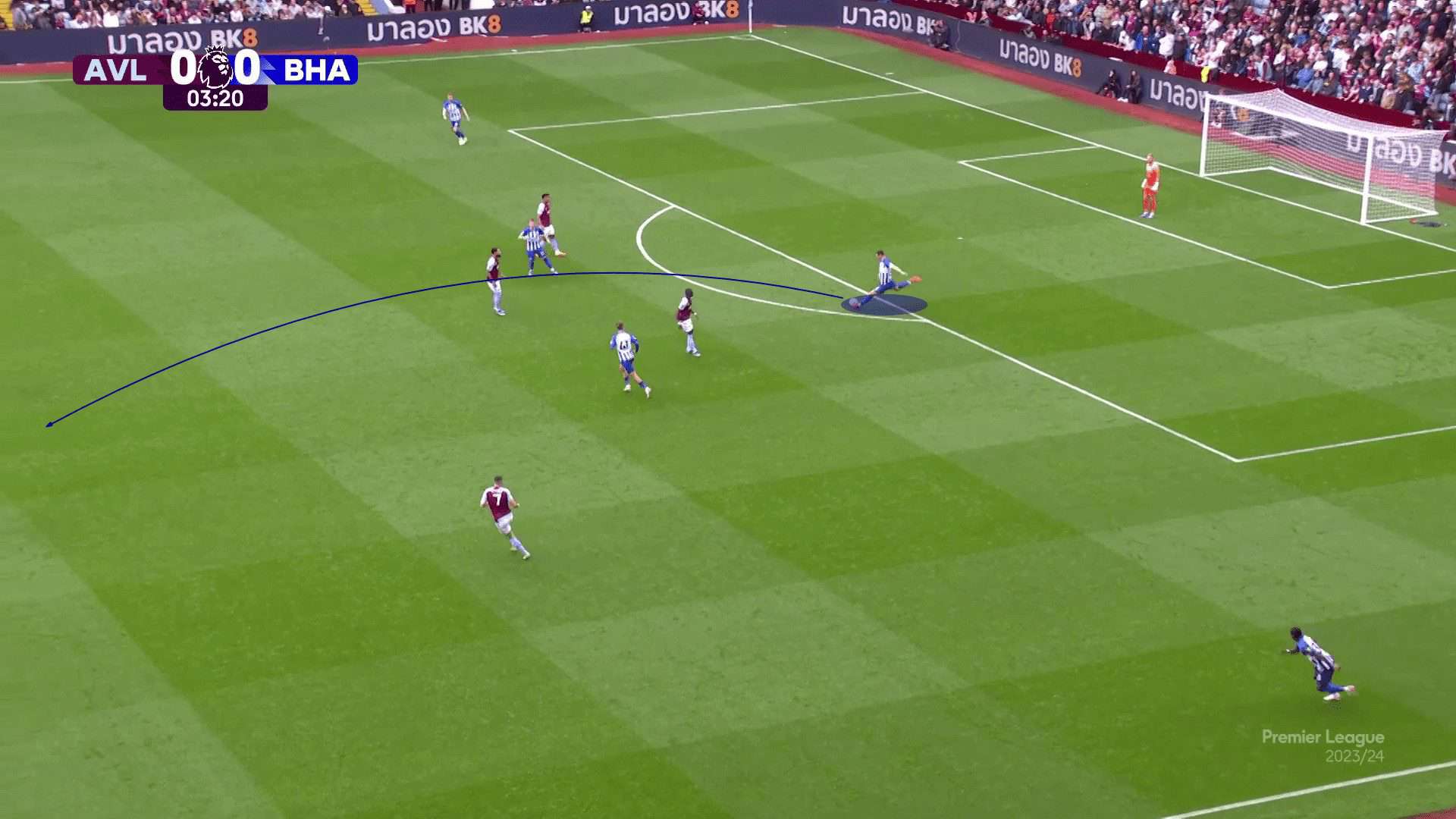
The difference between Man United’s diamond structure and Villa’s was that the Villans’ front two was narrower and focused on closing down on Brighton’s double-pivot rather than pressing the centre-backs. Additionally, the role of the ball-far winger to press the midfielder left by one of the strikers alongside the centre-backs could drop all the way to prevent the opposition’s forwards from receiving in between the lines. Finally, the blocking of the passing lane towards the goalkeeper by the other striker when the ball goes to one side made it much more effective against the Seagulls.
Watkins and Diaby are focusing on Gilmour and Hinshelwood with Douglas Luiz behind them. Steele played the ball to Webster in the right half-space. Webster received under pressure from Watkins while Luiz was marking Gilmour, and Diaby was going to block the pass towards Steele. Here, we see McGinn stepping to press Hinshelwood, and the Scottish midfielder intercepts the ball before finding Watkins in a dangerous transition for the home side.
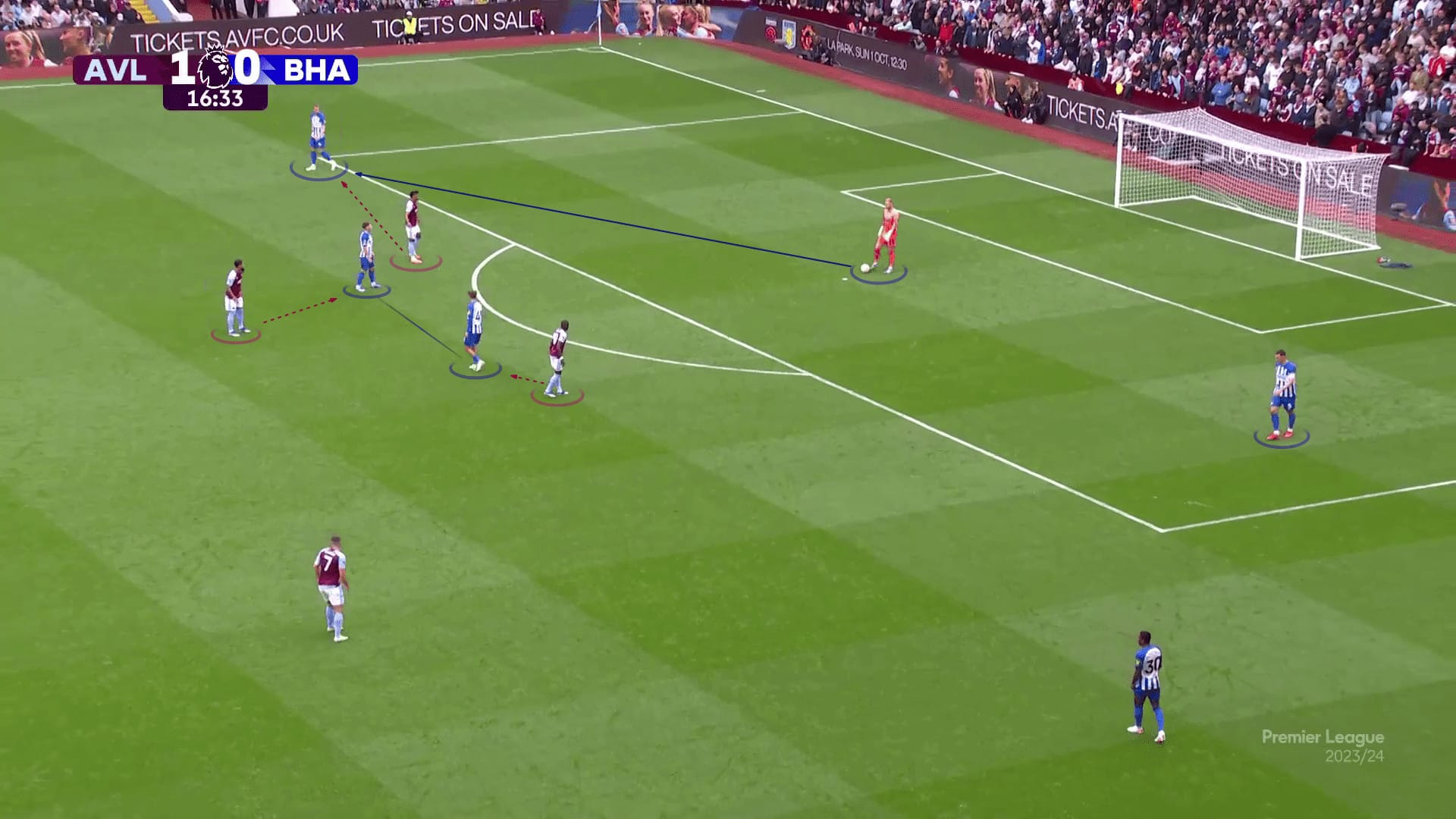

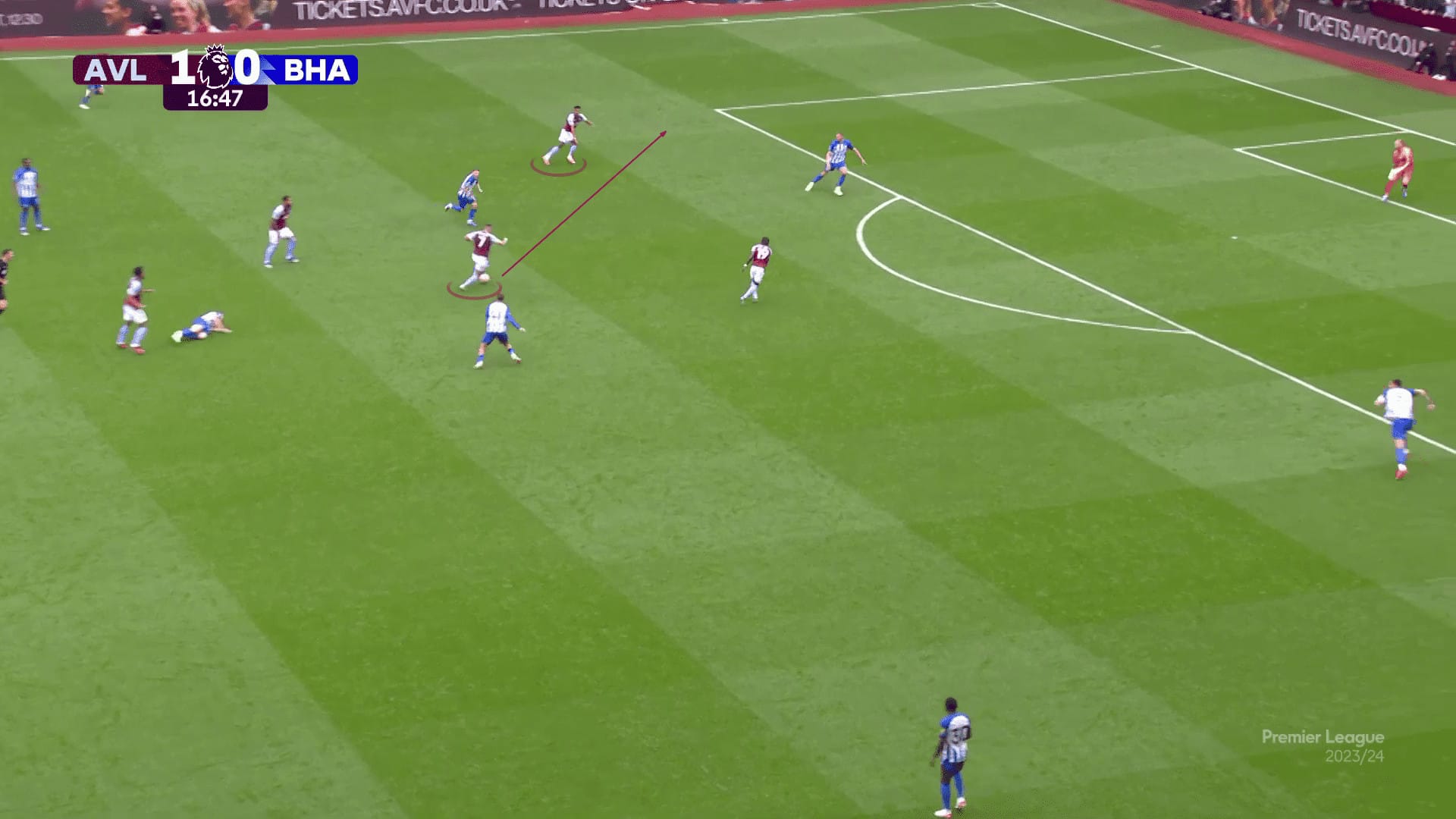
Unfortunately for De Zerbi’s team, they lost the game 6-1 at Villa Park, with their next game against Liverpool at the AMEX Stadium. Would Jürgen Klopp use the same shape to stop Brighton’s build-up? And how would Brighton’s Italian manager try to adapt his team and be ready for the Reds? Let’s move on and analyse Brighton’s build-up vs Liverpool.
Brighton vs Liverpool
Brighton had the same build-up structure of 2-4-4. Dunk and Igor Julio played as the two centre-backs, along with Solly March as a left-back and Veltman as the right-back. The double-pivot of Groß and Carlos Baleba was deployed behind a front four of Kaoru Mitoma, Ferguson, João Pedro and Adingra.
They faced the same diamond shape of pressing from Liverpool in which Mohamed Salah and Darwin Núñez were closing the passing lanes towards the pivot while being ready to press the centre-back with the ball, as shown here.
On this occasion, when Dunk got the ball, Núñez pressed him, leaving Brighton’s pivot to be marked by Salah and Dominik Szoboszlai. Elsewhere, Luis Díaz and Harvey Elliot are marking the full-backs Veltman and March, while Alexis Mac Allister is marking Ferguson, as Virgil van Dijk drops aggressively with Pedro.


De Zerbi adapted his team by dropping Groß to form a back three against the opposition’s front three, with Szoboszlai pinned by Baleba in the midfield. A 3v2 occurred in the first line of build-up, giving the Seagulls more time on the ball.

Both Dunk and Igor subsequently had more space to carry the ball and escape the press. However, the centre of the field is still congested, and they couldn’t progress centrally as they would like. Van Dijk intercepts Igor’s pass to Pedro while MacAllister is marking Ferguson.

With Groß dropping and Szoboszlai starting to follow him, Mac Allister had to step up to mark Baleba, leaving Matip responsible for Ferguson, which meant there was a 3v3 situation on the opposition’s backline — definitely not favourable for the defending team, especially as Van Dijk was dropping with Pedro in the midfield.
Even with the home side either having a numerical advantage at the first line or having a 3v3 situation up front, they still couldn’t progress centrally as they would prefer and were forced to play long balls towards either the full-backs or the winger as below Groß played a long ball towards Veltman which Luis Diaz anticipated.


Until the middle of the first half, Liverpool’s first line of pressure was keen on not pressing the goalkeeper, Bart Verbruggen. Nevertheless, Klopp’s side decided to press the Dutch ‘keeper aggressively as the distance between him and Groß was close, so there was less time for him to get away with an inaccurate pass.
Once again, we can see Groß dropping between the two centre-backs, with Szoboszlai following him this time while Salah and Núñez marked the centre-backs. As Groß played the ball back to his goalkeeper — a pressing trigger — Szoboszlai immediately pressed him while keeping Groß in his cover shadow.
Now, his only passing option was Dunk on the right side, who was pressed by Núñez and tried to play the ball centrally towards Pedro. Still, MacAllister anticipated it, and we can notice how Harvey Elliot’s central positioning left March isolated on the left side.
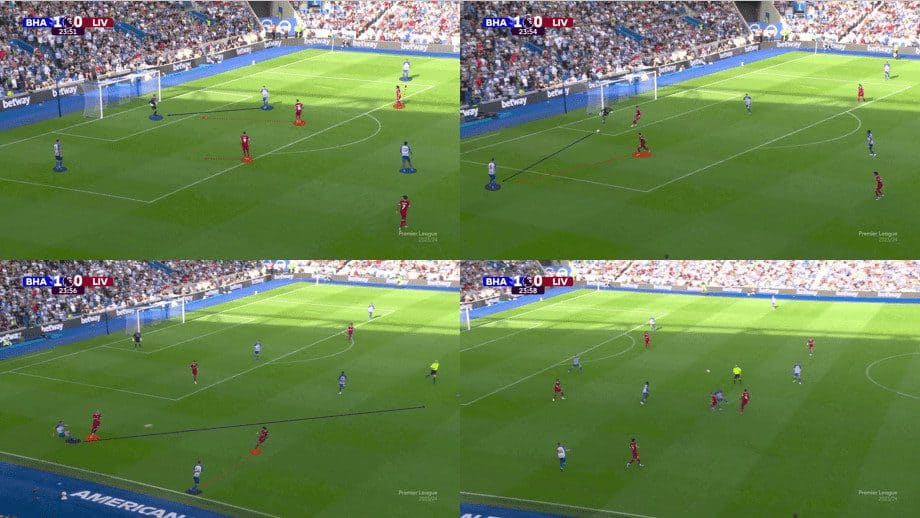
Another time, the Hungarian midfielder was pressing Verbruggen, forcing him to go on the left side towards Julio, who was being pressed by Salah. Notice now how Díaz was closer to Baleba than Veltman.

Since last season, no one has wanted to press Brighton’s goalkeeper, as although it’s a common pressing trigger for the opponent, Brighton’s Italian manager turned it into a weapon to easily escape the opposition’s pressure, and Liverpool didn’t risk that at the beginning of the game, but they switched the idea and pressed him strongly as he got the ball making the use of the short distance between him and Groß as well, as Brighton lacked numbers in the centre.
In this example, it was Núñez who pressed Verbruggen with a curved run, forcing him to one side, so his only passing options were Julio — marked by Salah — and Groß — pressed by Szoboszlai. What Brighton used to do in this situation is that Groß found Dunk as the third man with the pass and escaped the press. Unfortunately, on this occasion, Szoboszlai’s pressing was successful and won a penalty that gave the Reds their second goal right before the end of the first half.


As we mentioned before when analysing the Manchester United clash, Brighton always prefer to escape the press through their pivot and have as many vertical passes as possible for better control of the game and to facilitate the creation of more threatening scoring chances, the dropping of Groß means they have one man less in the midfield and couldn’t invade the opposition’s pressing through the centre much.
Yes, they had more time on the ball and could find their full-backs with a direct ball until Klopp decided to press the goalkeeper, but it’s not their preferred offensive approach, and they couldn’t create many scoring chances in the first 45 minutes.
Consequently, during the second half, De Zerbi decided that the shape would return to the normal 2-4-4, with Groß and Baleba as the double pivot, aiming to create better depth and penetrate the field in their own way.
As we discussed during the second half, Brighton returned to their normal 2-4 build-up shape with the same pressing scheme from the away side.

And Brighton still couldn’t progress through their box-midfield thanks to the diamond midfield shape of the opposition. Dunk is forced to go long, looking for Pedro, who lost the aerial duel against Joël Matip.


Conclusion
Since De Zerbi’s appointment in September 2022, Brighton have been well-known for their entertaining offensive football. Finishing the Premier League in sixth place and qualifying for the UEFA Europa League for the first time meant that they would face more obstacles this season to encounter their style of play, and it seems like they’ve begun struggling to impose their favourable football, especially against Aston Villa and Liverpool from whom they gained only one point.





Comments